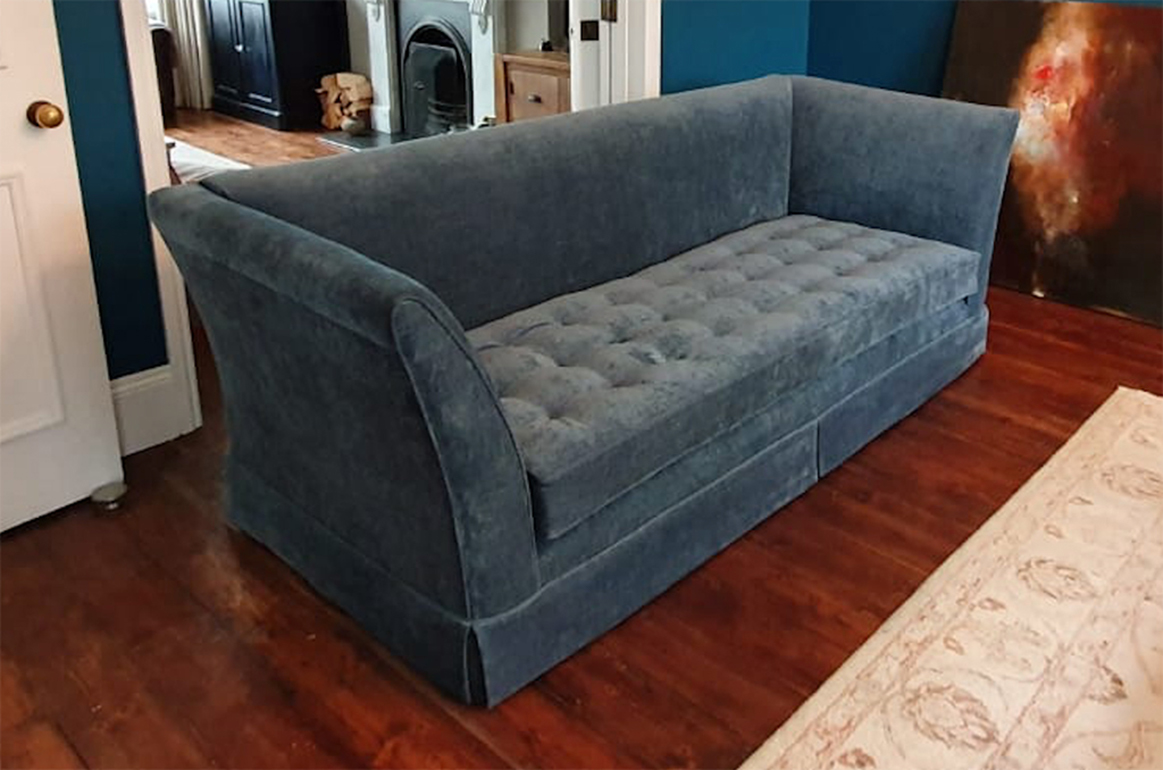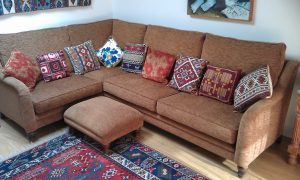If you’re a beginner, I’ll share with you some upholstery tips that I learned during my time in upholstery classes here in Maryland. I had an excellent teacher that taught me a few things that I’ll pass on to you, in the hopes that you, too, will be able to upholster your own furniture (and save a bunch of money!).
Upholstery Tips #1 – Use Your Old Fabric As a Pattern
Okay, let’s start with the obvious. Even for people who are newbies, you may already know that the smartest thing you can do when reupholstering furniture is to save the old fabric that you remove (using a tack remover). When you save the old fabric, you’ve got the blueprint for the exact shape of the fabric that needs to go back onto your piece of furniture. I like to add a bit more of fabric just in case my fabric doesn’t cooperate or stretch the way the old existing fabric does. Add about 1/2″ extra around the perimeter of the old fabric. Use chalk to mark the fabric, which won’t permanently mess up your new fabric.
Just remember: you can always trim down excess fabric, but if you cut a pattern too small, you can never add extra fabric!
Upholstery Tips #2 – Easily Cut Straight Lines Without a Yard Stick
One of the hardest things when working with fabric is figuring out how to cut a straight line. Why is this important? Well, imagine reupholstery a chair and you need each piece of fabric to be 20″ x 20″. You can place a yard stick on the fabric and try to measure properly to get a right angle so that all the sides are straight, but from my experience, the likelihood of that happening is slim, especially if you’re a beginner!
Instead, use this trick that my upholstery teacher taught me:
STEP 1: Snip the edge of the fabric across the selvaged (fuzzy edges on the left and right side).
STEP 2: Pull the edges apart and find a loose thread.
STEP 3: Pull the loose thread, and move the fabric along the thread, creating a run in the fabric. Be careful not to pull too hard or else the loose thread may break.
STEP 4: Keep pulling the thread and cinching the fabric to create a longer run in the fabric.
STEP 5: Use your scissors or a rotary cutter to cut along the run. You will be guaranteed to have a straight cut across your fabric!
Upholstery Tips #3 – Find the Centre of Everything!
It’s tempting to just lay your fabric on your furniture that you’re reupholstering and just decide to….well, staple it in place as best as you can. But there is a method to how the professionals upholstery furniture:
They find the centre of everything.
That means that before they place fabric, they’ve located the centre of their furniture along the edge. They’ve found the centre of their fabric. And they strategically place all the materials for best results.
Here’s how to find the centre:
STEP 1: Measure the width of your chair’s edge. Divide the measurement in half and then mark the centre. (For example, if your chair’s seat is 24 inches wide, mark the chair’s edge at 12 inches in the centre).
STEP 2: Fold your fabric piece in half evenly to find the centre of your fabric. If you’re placing a special motif in the centre of your chair, be sure that the centre of your fabric is the centre of that motif. To mark the centre, fold your fabric at the halfway mark and snip your fabric’s edge at a slant. When you open the fabric up, you’ll get a nice little “V” at the centre of your fabric, with the “V” notch cut into the seam allowance of the fabric.
TIP: Make sure your “V” notch is small so that you don’t cut into the area of your fabric that will be visible once your furniture is upholstered.
STEP 3: Match up the centre of your chair to the centre of your fabric.
STEP 4: Place a single staple to secure the fabric to your furniture.
Upholstery Tips #4 – Start in the Middle and Work Your Way to the Sides
This tip is the next step to why you found the centre to your fabric and project.
When I first started upholstering furniture, I used to start stapling at the corners. I’d fold and staple the corners as neatly as I could, and then I would pull the fabric to the other corner, convinced I was doing it right.
But imagine my dismay when I’d look at my fabric and see that the pattern was crooked, stretched, lopsided, and looked bad. “What am I doing wrong?!”
What happened was that I wasn’t matching up the centre of my fabric with the centre of the chair (as mentioned in Tip #3). So while I thought I was starting in a good place (the corners), whatever placement of the fabric I thought I had positioned would get shifted out of place.
While this isn’t as big of a deal if you’re using solid fabric, this definitely won’t work with patterns or any fabric where you want to place a certain motif in the centre of your chair.
So instead of starting at the corner, start at the centre of your furniture, where you placed that single staple. Then, begin to pull towards the corners, making sure that all the wrinkles are pulled taut. This will guarantee that the carefully placed fabric, motif, or pattern, won’t shift while you’re pulling!
Upholstery Tips #5 – Use a Pneumatic Stapler Whenever Possible
If you’re a beginning DIYer, you might have an Arrow Fastener T50 heavy duty stapler like this one. These do and can work when doing simple reupholster projects like dining room chairs that just need a new layer of fabric.
However, if you’re planning to do lots of reupholstery projects, I highly recommend you buy a pneumatic stapler. These are what the professionals use and run on an air compressor.
Also, when building up lots of layers of fabric, lining, dacron batting, etc., small handheld staplers don’t go through all those layers into the wood quite as easily. So a pneumatic stapler is your friend. Whichever brand of pneumatic 22-gauge upholstery stapler you buy, be sure the tip allows you to get close to the edge of whatever you’re stapling. Some pneumatic staplers don’t allow you to get close to the edge.
TIP #6 – Pay Attention to What Gets Removed First, Second, Third
When I was reupholstering my wingback chair, one thing was very clear: pay attention to what gets removed first, second, third (etc.) The reason why is because how you remove parts of the chair will tell you how it should be put back together, and in the correct order.
For example, in the picture below you see that the fabric on the right was removed first, followed by the curve-ease (the metal strip that holds the outside fabric in place), then the cording, and then the fabric on the left.
When the chair is upholstered, you’ll put it back together again in the opposite order.
TIP: I always recommend taking lots of pictures and videos before and during the process so you can look back on it while you’re working!
TIP #7 – The “Pinch Test” is Your Friend
How do you know if you upholstered a piece of furniture properly? Well, one clue is how many wrinkles you have. Lots of wrinkles means you didn’t pull your fabric tightly enough around the piece of furniture. Sometimes they’re clearly visible, but other times, it looks smooth, but still has some slack.
The best way to test this is what my upholstery teacher called the “pinch test.”
TIP #8 – Hire Professionals to Make Your Upholstered Buttons
Most craft stores sell button kits that allow you to make your own DIY buttons. But honestly? They’re pretty cheap and don’t look that great. They’re good in a pinch. But if you’ve got professional upholsters nearby, hire them to create your upholstered buttons. They’ve got professional button machines that can create amazing buttons. Take them some of your fabric and they’ll create them for you. Not only will they last longer but they’re look better. I think I paid about $2.00 per button.
While this can be expensive if you’ve got a large tufted piece of furniture, but you’ll get better results. Who doesn’t want that?
TIP #9 – Don’t Be Afraid to Use Tack Strips
Tacks are hard to use because they often are crooked, irregularly spaced, and–well, just difficult to hammer in consistently. Don’t be afraid to use tack strips, which are one long strand of perfectly spaced tacks. All you’ve got to do is nail them into place. It also helps keep kids from pulling them out! (Ask me how I know this….LOL).
If you do decide to use individual decorative tacks, order them from Amazon, and buy more than what you think you’ll need (believe me–you’ll ruin some of them while hammering them in). Use a piece of cardboard as a template for keeping them straight, with slits about 1/2″ apart.
While they still won’t be perfect, this does help! Have a good tack remover on hand so that you can easily remove any that get bent or uneven.
TIP #10 – Snip and Fit Your Fabric Around the Furniture’s Hard Edges
What I have learned about upholstery is that the difference between the professionals and the beginners is the ability to fit the fabric around the fixed parts of furniture, like a glove. They know exactly where to snip and fit, where to pull, and how to staple it into place for best results.
Remember from TIP #3 and #4 how you should find the centre of the fabric and match it to the centre of edge of the chair? How you’ll start with a single staple in the middle and then pull tight to the corners?
Well, you must pull out the slack from the fabric first and then snip while fitting the fabric around the furniture.
For example, when I reupholstered two dining room chairs in gorgeous velvet, I pulled the fabric taut, then snipped carefully around the chair legs, securing the fabric in place with staples, and then folding the edges of the fabric up to create a beautiful profile around the legs.
If I had snipped and then pulled tight, the cut would have been misaligned.
For more information on Upholstery Tips contact Hill Upholstery.
The original version of this article was published in thriftdiving.com




